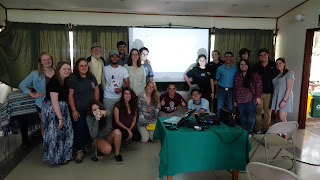Dr. Ribble and Javier gave a presentation about popular culture and social policy as explained in chapter three of the Costa Rican Reader. The presentation explored topics ranging from politics to race and language to religion, and
beyond—and our class conversation following the presentation contained a wide range
of social topics as well.
The Costa Rican population consists of a wide range of ethnic groups including Spanish, African, and the indigenous peoples. However, the majority of people identify as Mestizo (a mix of Spanish and indigenous) or Mulatto (a mix of Spanish and African). Due to the abundance of mixed race people, racism in Costa Rica is essentially nonexistent. The small remaining indigenous population remains present within the country primarily through artwork, but otherwise is not culturally prominent.
As far as religion goes in Costa Rica, the constitution declares Catholicism as the official national religion, but supports freedom of religion. As a result, only 43% of Costa Rican citizens identify as practicing Roman Catholics, which we noted is significantly less compared to other Latin American countries. However, religious themes and traditions remain deeply ingrained in day-to-day conversations and activities of natives.
Through public policy, healthcare and education are highly prioritized by the government. So much so, in fact, that there is a literacy rate greater than 98% and Costa Rica lands the #1 position on the Happy Planet Index, suggesting strong satisfaction with lifestyle among citizens. This is in part due to the strong healthcare system put in place while working to cure mass health problems (i.e. hookworm diseases), as well as incentivizing families to send their school by providing a stipend for education.



No comments:
Post a Comment